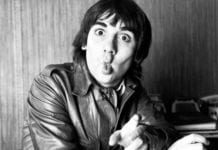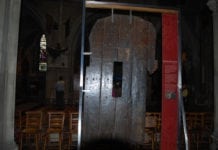Ballpoint Pen? What’s That Then?
Prior to the 1880’s the only way to write anything down onto paper was to use something that could be fashioned into a nib, such as a feather or piece of wood or shell, and dip it into an inkwell. Or use a pencil.
That is unless you had one of those fountain pens that had become popular with the rich and famous but many of them still had to be dipped in ink until the 1880’s when fountain pens began to be mass produced for the first time.
However, if you were a humble tradesman you probably couldn’t afford one of those. A tradesman such as the leather tanner, John J. Loud, for example.
During the early 1880’s John J. Loud, from Weymouth, Massachusetts, had been experimenting with ideas for things he could use to mark his leather products, without much success.
The fountain pen that he had often failed to work and so Loud set about designing a pen that had a thin metal tube with a tiny, rotating steel ball held in place by a small burr.
His idea was to fill the tube with ink, let it coat the ball and continue to do so as it rolled across the leather, leaving ink marks in whatever pattern he chose to make, including words, obviously.
Loud was excited by his design and even filed a patent for a ‘roller ball tip marking pen’ which was awarded on 30 October 1888 in his own name.
The problem Loud faced was that whilst his design worked adequately on leather, and other rough surfaces, it was not so efficient on smooth surfaces, such as paper. Loud realised that with a little development he could refine his design but was told by everybody he approached that he was wasting his time.
After all, the perfect pen had already been designed and was now in mass production. Why, they even delivered their own ink in those modern times and there was no more need for dipping, or inkwells, or any smudges.
‘You are too late Mr Loud,’ they told him, ‘we already have the perfect pen thank you.’ And with that John L. Loud went back to stitching handbags, or shoes, and no more was heard of him.
No more was heard of his idea either until 1935 when a Hungarian newspaper editor was becoming annoyed by the amount of time he wasted filling up his, by then, old fashioned fountain pen. He was also fed up with clearing up ink smudges and his nib tearing through the newsprint.
But he noticed how the ink from his newspaper press dried ten times faster than that of his pen and so Landislas Biro, with some help from his brother Georg, a chemist, set about finding a solution.
Over the following few years Landislas experimented with ball tipped designs of the exact nature John J. Loud had patented all those years earlier whilst Georg developed ink samples using the thinner, lighter inks of the printing press.
During the summer, whilst taking a break from their work they were at the seaside where they met a fascinating old gentleman who loved their model of a ball point pen. The old man turned out to be Agustin Pedro Justin, the serving president of Argentina who urged the brothers to move to his country where he would help them fund a factory.
The following year, as war broke out in Europe, the brothers did just that and fled to Argentina, stopping off in Paris to file a patent along the way. Once they had settled in they found no shortage of investors and established a factory in 1943.
But they found their new pen didn’t work very well at all and they had to go back to the drawing board and refine their design.
The second version faired a little better but sales throughout the country did not meet their expectations and eventually the money ran out. Although not before American pilots, who had been stationed in Argentina during the war, returned to America full of enthusiasm for the new pens that worked perfectly at altitude and did not need re-filling very often.
The U.S Air Force sent specifications to a handful of American companies and one of them, in an attempt to corner the market, paid the Biro brothers half a million dollars for the U.S manufacturing rights to their patent.
Meanwhile, a Chicago salesman called Milton Reynolds, who had bought several Biro’s whilst on holiday in Argentina, thought he could avoid any legal problems because the original patents had expired and so he set about copying Biro’s design, (or Loud’s depending upon your viewpoint) with sufficient improvements that allowed him to obtain his own U.S Patent.
Reynolds then showed his prototype to his friend Fred Gimbel whose family owned the Gimbel Department Stores who were, at one time, the largest store chain in the world.
Gimbel arranged a clever marketing campaign and launched the new ball point pen in New York City on 29 October 1945, just two months after the end of the Second World War.
Priced at $12.50, the cost of a single night in a decent New York City hotel room, Gimbel’s sold out their entire stock of 10,000 within two hours as 5000 people crowded into the shop.
The New York Police Department had to despatch fifty officers simply to maintain crowd control. Over the following six weeks the Reynolds International Pen Company worked around the clock to make eight million pens in order to keep up with demand.
Reynolds became a very wealthy man and even bought a magnificent French estate, the Chateau Mesnil St. Denis to use as the headquarters of his European division.
But Reynolds was an astute businessman and realised other companies would soon be flooding the market with cheaper versions of their own ball point pens and so he sold his company and retired to South America in 1947. – Albert Jack
Albert Jack AUDIOBOOKS available for download here
More Awesome Inventions with Albert Jack






































